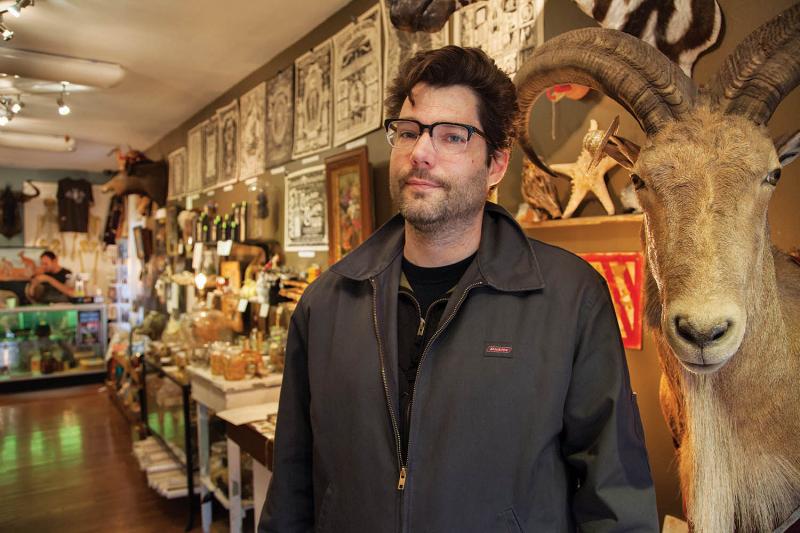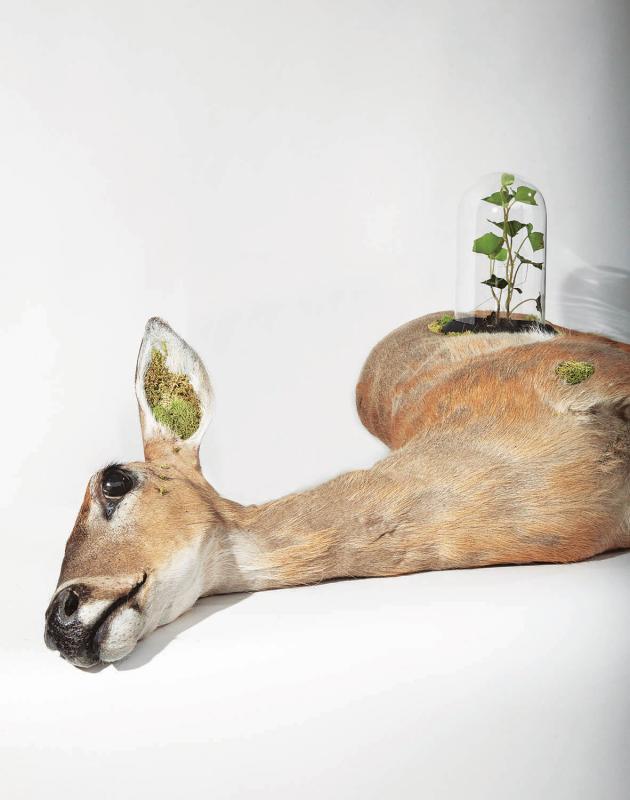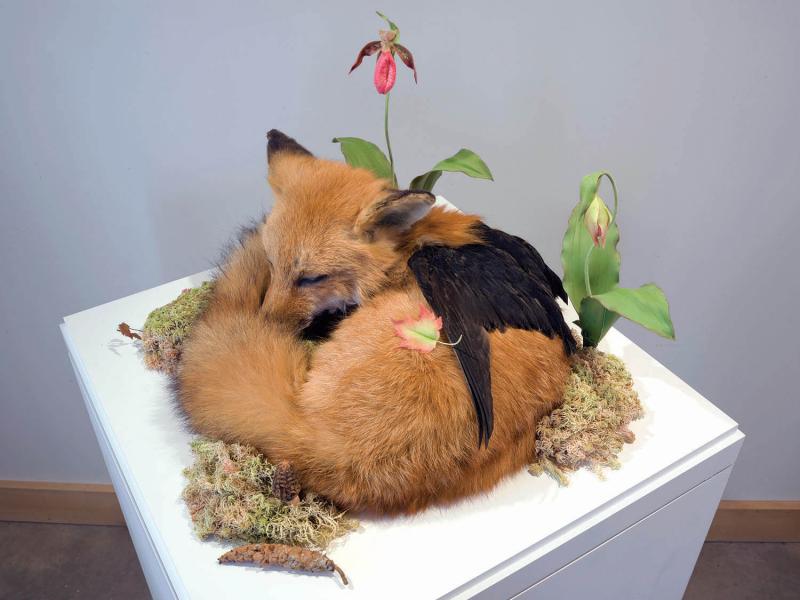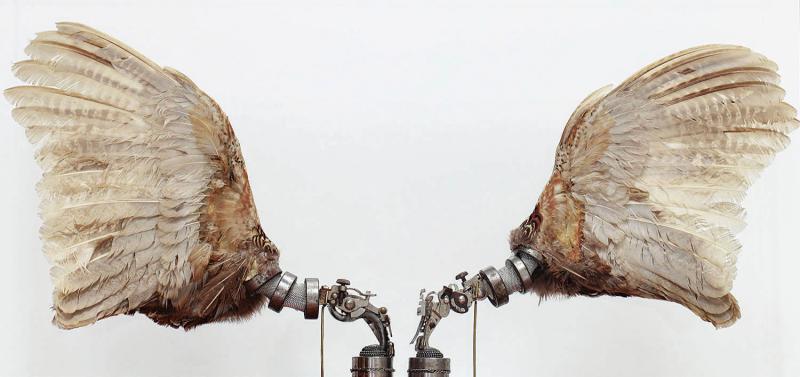On May 13, 2014, Katie Innamorato and Robert Marbury joined Joshua Foer onstage at the Institute Library in New Haven, Connecticut, as part of the ongoing series “Amateur Hour,” in which various tinkerers, zealots, and collectors discuss their obsessions. Innamorato is an award-winning taxidermist who teaches at the Morbid Anatomy Museum in Brooklyn, New York. She utilizes roadkill, scrap skins from the garment industry, nuisance animals, and pet-industry casualties to create both traditional and abstract taxidermy. Marbury, a multidisciplinary artist, is the cofounder and acting director of the Minnesota Association of Rogue Taxidermists and is a judge for the annual Carnivorous Nights Taxidermy Contest in Brooklyn. His book, Taxidermy Art: A Rogue’s Guide to the Work, the Culture, and How to Do It Yourself, was published in 2014.
Joshua Foer: Katie, it looks like you’re giving a massage to a very bloody squirrel. What’s going on there?
Innamorato: I like to freeze everything before I work on it for at least two weeks to a month, because fleas and ticks will stay on a carcass and live for a while. Freezing helps kill off mites and parasites, at least slow them down. It also makes it easier, especially when I give classes, to have the animals at least a third to a half frozen when I skin them because—especially when it’s someone’s first time skinning an animal—they have a tendency to cut down into the body. When it’s still frozen, you’re not going to get a big mess all over the place. It’s easier to manage them when they’re still partially frozen. So in this case I was massaging the squirrel to open up the limbs, so that I don’t accidentally cut into the armpit or anything like that. You want to just loosen everything up, so that it’s easier to pry the limbs out of the skin later.
Marbury: Now, Katie’s using a roadkill squirrel, which means it has died of trauma. She doesn’t know what trauma, which is why you would feel around to see what’s going on with it. If someone hunted something traditionally, there would be a bullet hole somewhere, and usually the rest of the body hasn’t had as much trauma. But when you start working with roadkill you learn very quickly that a lot of stuff can happen.
Katie, where did this particular squirrel come from?
Innamorato: I have a stockpile of roadkill that either I’ve picked up or that friends have picked up for me. My mentor and other taxidermists give me a lot of things. Or I get nuisance animals, ones that are in people’s attics, and you can’t release them or they’ll keep coming back. So they get put down.
And then these people call you?
Marbury: Once you say, “I’m a rogue taxidermist,” everyone shows up with animals.
Innamorato: When I was going to school in New York, every day someone would text me on their way to campus: “I saw whatever, I don’t even know what it is—a skunk on the exit of 83,” or “I saw something orange, you might want to check it out.”
Marbury: By the way, the best season to be picking up roadkill is clearly in the winter. Summer’s not the best—when you come up to it you can tell pretty quickly whether or not you even want to touch it.
What’s the history of traditional taxidermy?
Marbury: Well, taxidermy came from collecting, and these cabinets of curiosities ended up creating our contemporary museums, galleries, libraries, and even circus sideshows and oddity shops. It all comes from this desire to preserve. A lot of it was for science. In Europe, many collections were ordered—birds over here, mammals over there—and you would create boxes for all these objects. Much of this preservation began in about the 1500s and 1600s, when early museums were starting to come together. By the Victorian age, you’ve got more museums and personal collections with taxidermy in them. The transition over to the US occurs with the diorama, where you’re starting to show the habitat of the animal as well as the animal as object. Not much has changed since then—this Victorian desire to show animals in this funny light continues today. You’ve got contemporary artist David Shrigley’s “I’m Dead” cat, and then you’ve got Walter Potter, probably the most famous anthropomorphic taxidermist. He was British, and when he created his collection, he did it so that people would come to his father’s inn.
When did Potter live?
Marbury: He was practicing in the late 1800s. And the reason he’s become popular again is because his entire collection was sold off and disbanded in 2003. So a lot of these classes in anthropomorphic taxidermy have become hugely popular. It helps that the work is small and quick. It’s gotten to a point where people can take these classes and make a mouse with a banjo and a mustache. Wouldn’t you say, Katie, that most of these classes are anthropomorphic?
Innamorato: Most of them, yes, and the reason behind it is, well, they’re goofy, and people enjoy that. They can just do whatever they want with the animal. But it’s also easier to make an animal look funny, rather than trying to get an animal to look anatomically correct. In a five- to seven-hour class, you’re not going to be able to learn the anatomy perfectly.
So, how did we get from these museum displays to people making all sorts of campy sculptures?
Marbury: So there’s a long answer and a short answer. The long answer is, you’d start with the ancient Egyptians and this desire to take your animal with you into the afterlife, to mummify it and preserve it. There were falconers in the 1300s who would make taxidermy pieces in order to catch birds and lure other falcons. Those were very early examples of taxidermy. But taxidermy really didn’t pick up until about the time of the Great Exhibition at the Crystal Palace in England in 1851, which featured an enormous amount of taxidermy that ranged from boxing mice to pets. The most famous one there was John Hancock’s piece, a representation of a gray falcon attacking a heron that’s going after an eel. That’s the first example of storytelling with taxidermy. It wasn’t just, This is a platypus… . This is a deer. Hancock told a story, he showed motion. That’s when things changed dramatically. In the US, we had a totally different relationship with nature than they had in Europe. The people who were making taxidermy in Europe, they had some cash, because they were the ones hunting for sport. They could afford it. If you were poor, you weren’t hunting. You didn’t have access to this. What was funding taxidermy was either science or hunting, which meant you were royalty. In the US, just the opposite: People who were hunting tended to be poor or tended to be living off the land. For them, taxidermy ended up being trophy pieces.
Why are rich people hunting in Europe and poor people hunting in America?
Marbury: Because of land. For the most part, people who were hunting were those living in the wilderness. They weren’t the ones living in the city. Cities had workers, but they weren’t the ones taking skins and making clothing. For example, something that’s becoming more popular again is brain tanning, which is a traditional way of tanning. You use the oils of the brain and smoke to create this tanned skin, which makes buckskin. The oils are actually going into the cells, and the smoke seals it in. It will create a supple, durable skin that does not rot, that can be soft if you do it properly.
So, Katie, tell us a little bit about how you’re going to start skinning this squirrel.
Innamorato: There are different ways to skin animals. Trappers usually do something called “case skinning,” where they hang an animal up by its ankles and then cut from one ankle across the butt to the other ankle. Then you just pull the skin off like a tube sock. That’s the worst for taxidermy because you have to sew that seam back up, and then you either have to do a ventral or dorsal incision to open up the skin. I prefer dorsal skinning, especially when I do classes, because if someone—especially someone who isn’t as experienced—cuts too far into the back, you’re not going to puncture anything; you’re just going into the spine or muscle. You’re just going to hit ribs. You’re less likely to puncture the stomach or the intestines or anything like that. And this helps cut down on the smell. It also helps limit goop. There’s also less sewing involved when you go down the back. I also like dorsal because an animal’s fur is generally longer on the back, it’s easier to hide your seam than on the belly. Belly fur usually isn’t as thick.
Do you have in mind what the squirrel is going to look like?
Innamorato: Not this one right now. Another pair I brought—a mother squirrel and its baby—got hit, and I found them within five inches of each other, the little baby behind the mom. I wanted to mount the two of them in the positions that I found them in, do a nice little shadow-box display with them.
Robert, you’ve been traveling the world documenting “rogue taxidermy.” What would differentiate what Innamorato is describing doing with those squirrels from more traditional taxidermy?
Marbury: Rogue taxidermy is artwork that utilizes traditional taxidermy materials in unconventional ways. A lot of the distinction is where you want to put it. If it’s going to go in an art gallery, then it leans toward rogue taxidermy. I’ve been going around meeting taxidermy artists, and some of them were very clear in saying, “I’m not a rogue taxidermist. I am a gallery artist who works in sculpture who just happens to use taxidermy.” That’s an interesting distinction, but what’s your intent? If her intent is to create an archetypal version of the animal, then she’s leaning toward traditional taxidermy. Making a squirrel that is a squirrel. If she wants to make a squirrel that is the representation of saudade, then maybe she’s an artist. A traditional taxidermist hypothetically has no interest in showing mournful loss or greed, or having a lion, for example, represent opulence and wealth.
It seems that taxidermy is having a bit of a moment right now. If you walk down Fifth Avenue, you’ll find these high-end fashion boutiques with taxidermy in their display windows. And if you go to Brooklyn, there’s taxidermy hanging on the walls of bars and people’s apartments. What accounts for this? Why is taxidermy all of a sudden a thing?
Marbury: I’ve spent a lot of time asking people, Why now? And it seems pretty complex. In some ways, we’re mimicking what was happening with the Victorians. The internet has caused this enormous change in how we’re doing work, much like the Industrial Revolution had. We have a lot more free time. We’ve also got these extended educations; we go through college, we go back, and we’re all interested in learning. And we’re interested in learning these crafts that require handwork, like pickling, or even yarn-bombing, which is like outdoor craft graffiti where people knit pieces and then put them on public sculptures or poles or bikes. This desire to have a tactile experience is very real. In terms of why people are doing taxidermy in Bushwick and in urban locations, I think a lot of that comes out of this desire to be rural and urban at the same time.
There are also taxidermy competitions, right? What happens at a traditional taxidermy competition?
Marbury: Well, traditional taxidermy competitions are devoted to the faithful representation of the ideal specimen of a certain type of animal. Imagine a dog show, and when they name the dachshund as the winner, you’re always sort of like, “The dachshund? I thought the Aussie shepherd looked beautiful!” The dogs haven’t been judged against each other, they’ve been judged against the ultimate, perfect breed.
That is a very different set of aesthetic criteria than what you were telling me makes rogue taxidermy interesting.
Marbury: Right. There’s a rogue-taxidermy competition in Brooklyn where people bring pieces they’ve either made or bought—Katie’s in that one pretty much every year. And what makes the Brooklyn competition interesting to me are the stories behind it. Yes, the result is important, but I’m very interested in what they’re trying to create and what the story is. But for a traditional taxidermy competition, the walls would be lined with, say, white-tailed deer, and there might be forty of them, and most of us would walk in and go, “Look at all those deer.” And a professional goes, “They screwed up the nose. The ears are awful. The eyes aren’t level.” It takes an enormous amount of time observing animals to figure out you didn’t get the eyes right.
I’ve heard you describe yourself as a “vegan taxidermist.” That sounds like an oxymoron.
Marbury: Well, those people tend to do re-creations. In traditional competitions there is a genre of re-creations, which could be fictional animals or using nonanimal parts. I do work that does not use taxidermy. I started taking thrown-out stuffed animals, as in toys, and using that fur and remaking them into another piece.
What do the traditional taxidermists make of you guys?
Marbury: Originally, it was a little bit touch-and-go. There was a feeling that taxidermy artists were mocking traditional artists. And that’s understandable, because a lot of young artists don’t take the time to understand the tradition and the skill. People often produce crappy work because they haven’t had the experience to learn the steps. So when they make a cat helicopter, which a Dutch artist made, my guess is that it’s not going to last very long, because he probably just skinned the cat and put it on a helicopter—boom. Traditional taxidermists are saying, “That’s not taxidermy, that’s not going to last. You don’t even know why you’re doing it, you don’t have the right materials.” But one of the things I’ve worked really hard with, and Katie is a perfect example, is I’ve worked really hard to try to open the conversation with traditional taxidermists, to have the museum taxidermists help people. Katie has been training under a traditional taxidermist, for example, and if she has a problem she gives him a call. And at that last Brooklyn taxidermy competition, one of my happiest moments was seeing that five traditional taxidermists came to watch the event.
Katie, how did you get involved in rogue taxidermy?
Innamorato: When I was younger, my favorite place to go was the Museum of Natural History in New York to see all the mounted animals. I wanted to be a vet when I grew up, and things kind of evolved from that. I started picking up really rotten, disgusting things off the side of the road when I was in high school. I would bury them in the backyard, and months later I would dig up the carcasses, for articulating, just to collect the skulls or bones. Then I started finding things that were fresher, and I wanted to try to utilize everything I could off the animal. I called a bunch of different taxidermists, trying to get people to call me back. I found this guy who had two daughters, neither one of them wanted to learn, and he basically took me on as an apprentice. I took a month-long mammal class with him, and for the last three-and-a-half years or so I’ve been working in and out of his shop. For the last year and a half, I’ve been traveling around teaching classes, doing my own work, and doing commissions.
What appeals to you about this? How did you decide this is what you wanted to spend your life doing? Something about this obviously speaks to you.
Innamorato: I think it’s interesting just to see how everything works from the inside out, and then being able to re-create it.
Marbury: Tell them about your fox.
Innamorato: I had a pet fox for nine months when I lived in New York. I rescued this second-generation domestic—they’ve been breeding them in Russia for fur and domesticating them for the last fifty, sixty years, and they have some breeders here in the US who breed them as exotic pets. I went to go meet this animal, because I figured I work with a lot of dead ones, I’m never going to have the opportunity to hang around with a live one. I go down there and this twenty-year-old kid, he had this poor fox, three months old, never saw a vet, he didn’t know anything about the species. So I took it from him and lived with it for nine months, then donated him to a local zoo. It’s this weird experience, living with a wild animal. I had to adjust to living with people again after that.
Marbury: Katie, how do foxes protect their food?
Innamorato: They pee all over it, and they hide it.
Marbury: There you go. Good pet.
Innamorato: And their pee is musky and oily. You can’t really wash it out. They smell like skunk and cat piss. Right after I donated him, all my friends were like, “We didn’t want to say anything to you for the last year, but you just smelled like piss all the time.”
Marbury: But it’s a very important lesson. People get committed to this lifestyle, where you start doing this taxidermy stuff, and you start having these interactions with animals that you didn’t have access to before. It changes your relationship.
So, how does one get from keeping a fox to opening foxes up and stuffing them?
Marbury: They’re not mutually exclusive. People working with taxidermy tend to be huge animal lovers. I have a friend who’s well known for her taxidermy art, her entire top floor is an aviary, with live birds. You know, a lot of them give money to organizations that protect animals. Conservation is a major part of taxidermy.
Incidentally, people sometimes use the word stuff, but that’s a derogatory term in the taxidermy community. In general, if a traditional taxidermist wants to dress someone down, they’ll say, you know, “He stuffs animals.” Because the idea originally was, for scientific mounts, you really were just stuffing them, you weren’t creating complex anatomy. Mounting is a more appropriate term for what taxidermists do, since they take skins and mount them over anatomical forms. One other thing I want to point out, because you start seeing the body take shape, is that there’s nothing inside. We all look at taxidermy and assume the bones are in there. Sometimes the skull is, but most of the time it’s a piece of foam, or it’s wood shavings, or, if it’s a small piece, it might just be cotton batting. If it’s a very large piece, it might be a wooden frame with wooden rib cages. It could be different things, but it’s not the body inside.
Innamorato: A lot of people do soft mounts, where you mount the head traditionally and the body is just stuffed with polyfill so it’s kind of cuddly, so you can leave it on your bed.
Marbury: What’s the largest animal you’ve mounted, Katie?
Innamorato: I’ve done a full-sized doe and a sixty-pound coyote I picked up off the New York State Thruway. I have a couple of bears to do—full bears. Skins, tanned, in the freezer.
What kind of a freezer are we talking about?
Innamorato: I have three chest freezers, all packed.
Marbury: One of my favorite things about traveling to meet artists is, when you go to their houses, they’re always like, “You wanna see the freezer?” Everybody’s got “the freezer.” I joke that you have to label stuff because you never know what you’re pulling out—you know, blueberries? Carcass?
Innamorato: You’ve got to keep an inventory.












